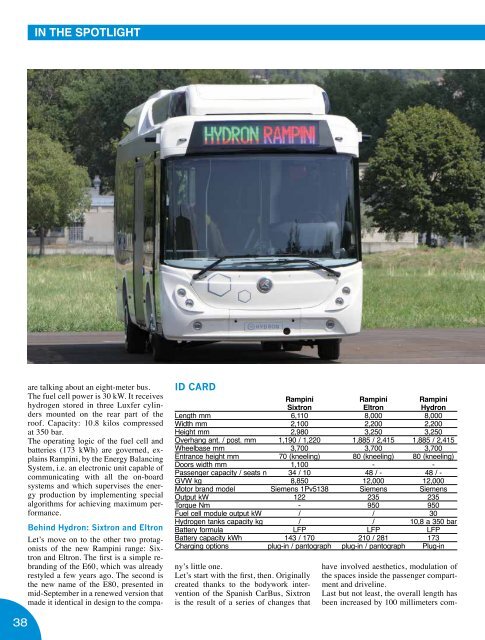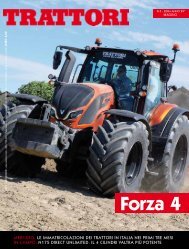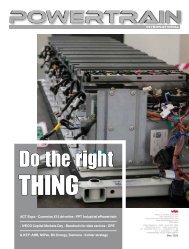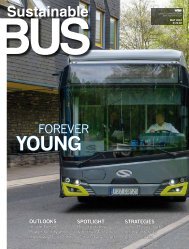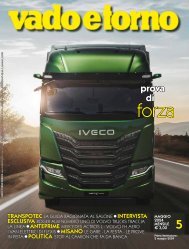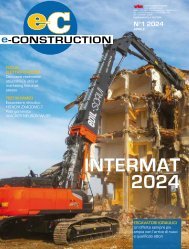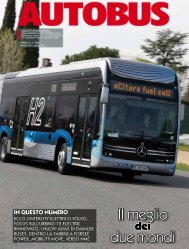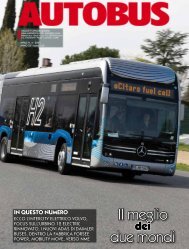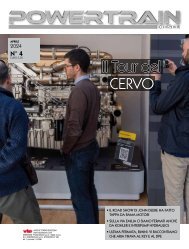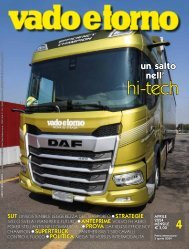SUSTAINABLE BUS 2-2023
Topics? A clear picture of fundings available for zero emission buses in UK, an insight on the fuel cell bus market, a glimpse of the largest electric bus fleet in Middle East (hint: Mowasalat). Again: focus on safety precautions in H2 bus depots, a commentary on the market for second hand e-buses (and battery residual value). Finally: technical presentations of VDL Citea new generation (cover story!), Iveco Bus Crossway LE CNG, Rampini Hydron (and new zero emission bus range)
Topics? A clear picture of fundings available for zero emission buses in UK, an insight on the fuel cell bus market, a glimpse of the largest electric bus fleet in Middle East (hint: Mowasalat). Again: focus on safety precautions in H2 bus depots, a commentary on the market for second hand e-buses (and battery residual value).
Finally: technical presentations of VDL Citea new generation (cover story!), Iveco Bus Crossway LE CNG, Rampini Hydron (and new zero emission bus range)
You also want an ePaper? Increase the reach of your titles
YUMPU automatically turns print PDFs into web optimized ePapers that Google loves.
IN THE SPOTLIGHT<br />
are talking about an eight-meter bus.<br />
The fuel cell power is 30 kW. It receives<br />
hydrogen stored in three Luxfer cylinders<br />
mounted on the rear part of the<br />
roof. Capacity: 10.8 kilos compressed<br />
at 350 bar.<br />
The operating logic of the fuel cell and<br />
batteries (173 kWh) are governed, explains<br />
Rampini, by the Energy Balancing<br />
System, i.e. an electronic unit capable of<br />
communicating with all the on-board<br />
systems and which supervises the energy<br />
production by implementing special<br />
algorithms for achieving maximum performance.<br />
Behind Hydron: Sixtron and Eltron<br />
Let’s move on to the other two protagonists<br />
of the new Rampini range: Sixtron<br />
and Eltron. The first is a simple rebranding<br />
of the E60, which was already<br />
restyled a few years ago. The second is<br />
the new name of the E80, presented in<br />
mid-September in a renewed version that<br />
made it identical in design to the compa-<br />
ID CARD<br />
Rampini Rampini Rampini<br />
Sixtron Eltron Hydron<br />
Length mm 6,110 8,000 8,000<br />
Width mm 2,100 2,200 2,200<br />
Height mm 2,980 3,250 3,250<br />
Overhang ant. / post. mm 1,190 / 1,220 1,885 / 2,415 1,885 / 2,415<br />
Wheelbase mm 3,700 3,700 3,700<br />
Entrance height mm 70 (kneeling) 80 (kneeling) 80 (kneeling)<br />
Doors width mm 1,100 - -<br />
Passenger capacity / seats n 34 / 10 48 / - 48 / -<br />
GVW kg 8,850 12,000 12,000<br />
Motor brand model Siemens 1Pv5138 Siemens Siemens<br />
Output kW 122 235 235<br />
Torque Nm - 950 950<br />
Fuel cell module output kW / / 30<br />
Hydrogen tanks capacity kg / / 10,8 a 350 bar<br />
Battery formula LFP LFP LFP<br />
Battery capacity kWh 143 / 170 210 / 281 173<br />
Charging options plug-in / pantograph plug-in / pantograph Plug-in<br />
ny’s little one.<br />
Let’s start with the first, then. Originally<br />
created thanks to the bodywork intervention<br />
of the Spanish CarBus, Sixtron<br />
is the result of a series of changes that<br />
have involved aesthetics, modulation of<br />
the spaces inside the passenger compartment<br />
and driveline.<br />
Last but not least, the overall length has<br />
been increased by 100 millimeters com-<br />
Under the Sixtron’s hood<br />
there is the Siemens<br />
1PV5138 three-phase<br />
asynchronous central<br />
electric engine with 122<br />
kW (22 more than the<br />
previous version).<br />
Batteries? In the name<br />
of LFP, with two options:<br />
143 and 170 kWh.<br />
Rampini quantifies the<br />
vehicle’s autonomy at<br />
175 and 215 kilometers<br />
respectively on the basis<br />
of the E-Sort 1 test.<br />
pared to the product signed with CarBus.<br />
Under the hood there is the Siemens<br />
1PV5138 three-phase asynchronous<br />
central electric engine with 122 kW (22<br />
more than the previous version).<br />
Siemens motor, LFP batteries<br />
Batteries? In the name of LFP, with two<br />
options: 143 and 170 kWh. Rampini<br />
quantifies the vehicle’s autonomy at 175<br />
and 215 kilometers respectively on the<br />
basis of the E-Sort 1 test. Compared to<br />
the previous version, the entire inverter-DMS<br />
package has been re-proposed.<br />
The axles? The front with independent<br />
wheels signed by ZF and the rear made<br />
in-house has been confirmed. The maximum<br />
capacity is 31 passengers. The air<br />
conditioning is provided by Autoclima,<br />
while a heat pump intervenes in the cold<br />
periods.<br />
On the eight-meter, everything changes.<br />
Moving on to the Eltron, up to 48<br />
passengers can board on the two-door<br />
version, 46 on the three-door version.<br />
Compared to the E80, of which it is an<br />
evolution, the length goes from 7.7 to<br />
eight round meters. The wheelbase is<br />
the same as the Sixtron, indicating a<br />
unique platform for the two vehicles.<br />
The motor, like its ‘brother’ with fuel<br />
cell module, has a maximum power of<br />
235 kW. As for the battery, mounted on<br />
the roof, the choice is between 210 and<br />
281 kWh. The first option makes it possible<br />
to free up a ‘slot’ of space on the<br />
roof where to place the pantograph (in<br />
a backward scan: two modules, pantograph,<br />
air conditioning system, two other<br />
pairs of battery modules).<br />
One of the peculiarities of the Rampini’s<br />
battery-powered buses is the fact<br />
that they can be equipped with a pantograph<br />
as well as charge the batteries by<br />
connecting to the tram catenaries. Obviously,<br />
these options are added to the<br />
standard plug-in charging in the depot<br />
according to CCS2 standard.<br />
38<br />
39


